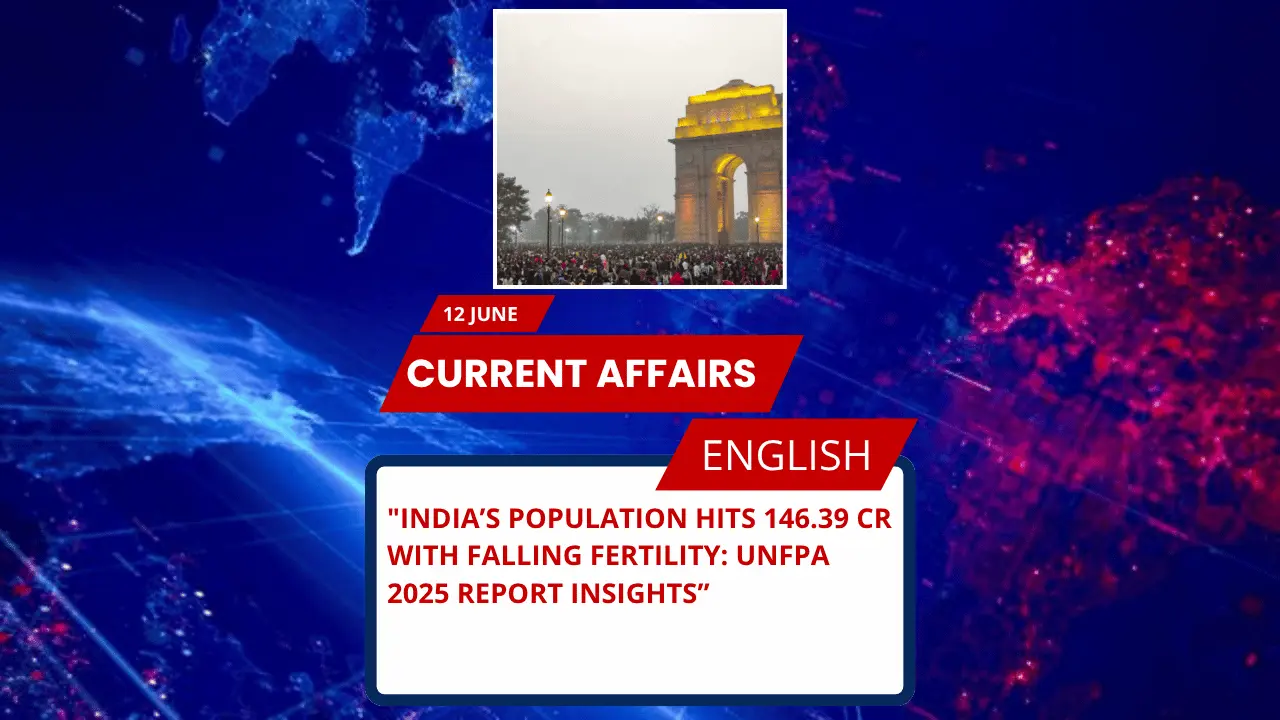
Key Points for SSC, UPSC & Other Exams
- India’s population: 146.39 crore as of April 2025.
- Total Fertility Rate (TFR): 1.9 – below the replacement level of 2.1.
- Report by: UNFPA – State of the World Population 2025.
- Global Population: 8.2 billion; fertility slowing globally.
- India’s demographic transition: Large working-age group (68%), youth (24%), and ageing (7%).
- Important Concepts: TFR, Reproductive Agency, Demographic Dividend.
- Policy Focus Areas: Reproductive health, elderly care, census completion by 2027.
UNFPA State of the World Population 2025 – Full Report Summary
Global Population and Fertility Trends
- As per the UNFPA’s 2025 report, the global population has reached 8.2 billion.
- The rate of growth is declining, but inequality remains between high- and low-income countries.
- The report emphasizes that the real fertility crisis is the unmet reproductive goals—not overpopulation or underpopulation.
Understanding Fertility – Concept and Features
Definition
Fertility is the actual number of children a woman has during her reproductive years (15–49 years).
Total Fertility Rate (TFR)
- TFR is the average number of children a woman is expected to have.
- Replacement Level: 2.1 (needed to maintain population).
- India’s current TFR: 1.9 – below replacement, indicating a demographic shift.
Key Determinants of Fertility
- Education
- Health & contraception access
- Economic conditions
- Family planning services
- Cultural and social norms
India’s Demographic Snapshot – 2025
- Total Population: 146.39 crore – now the world’s most populous country.
- TFR: 1.9
- Expected Peak: 170 crore in 40 years, then stabilization.
- Demographic Composition:
- 0–14 years: 24%
- 10–19 years: 17%
- 15–64 years (working age): 68%
- 65+ years (elderly): 7%
- Life Expectancy:
- Men: 71 years
- Women: 74 years
Global Fertility Challenges
Declining Fertility in Developed Nations
Countries like Japan, Italy, South Korea are seeing TFRs below 1.5, leading to ageing concerns and shrinking workforces.
High Fertility in Fragile States
Regions like Sub-Saharan Africa have TFRs above 4, which strain resources such as healthcare, education, and employment.
Reproductive Inequality
Over 200 million women globally lack access to contraceptives, maternal health services, and reproductive autonomy.
Policy Path Ahead for India
- Census Completion by 2027: Essential for updated policies based on real-time data.
- Improve Reproductive Healthcare: Expand access to contraception and maternal care.
- Balance Policies for Youth and Elderly: Develop simultaneous strategies for the needs of both groups.
- Promote Women’s Autonomy and Education: Vital to address fertility disparities and empower reproductive choices.
State/Organization Info for Exam Relevance
UNFPA – United Nations Population Fund
- Headquarters: New York, USA
- Founded: 1969
- Mandate: Sexual & reproductive health, population data, and gender equality
- Reports: State of the World Population (Annual)
India (Mentioned in Report)
- Capital: New Delhi
- PM: Narendra Modi (as of 2025)
- Important Rivers: Ganga, Yamuna, Godavari
- National Parks: Jim Corbett (Uttarakhand), Kaziranga (Assam), Sundarbans (West Bengal)
MCQs Based on the Topic
Q1. As per the UNFPA’s “State of the World Population 2025” report, what is India’s Total Fertility Rate (TFR)?
A) 2.1
B) 2.5
C) 1.9
D) 1.6
Answer: C) 1.9
Q2. Which organization publishes the “State of the World Population” report?
A) WHO
B) UNDP
C) UNFPA
D) IMF
Answer: C) UNFPA
Q3. What is the replacement level fertility rate?
A) 1.8
B) 2.0
C) 2.1
D) 2.5
Answer: C) 2.1
Q4. According to the 2025 report, what percentage of India’s population is in the working-age group?
A) 58%
B) 64%
C) 68%
D) 72%
Answer: C) 68%
Q5. Which of the following countries is facing a falling fertility rate below 1.5?
A) India
B) Japan
C) Nigeria
D) Brazil
Answer: B) Japan
UPSC Style FAQs – With Answer Writing Format
Q1. What are the main objectives of Population Education and what measures should be taken to achieve them in India?
Answer:
Introduction:
Population education aims to equip individuals with knowledge about population dynamics, responsible parenthood, and the impact of population on resources and development.
Main Objectives of Population Education:
- Awareness: Create awareness about population issues and their impact on socio-economic development.
- Attitude Development: Promote responsible reproductive behavior.
- Skill Development: Provide skills for decision-making related to health, family size, and resource use.
- Gender Equality: Encourage equal participation of women in decision-making and reproductive health.
Measures to Achieve Objectives in India:
- Curriculum Integration: Introduce population education in school and college syllabi.
- Strengthening Family Planning Services: Increase access to contraceptive services, particularly in rural and underserved areas.
- Community Awareness Programs: Use mass media and local outreach to inform people about reproductive rights.
- Empowering Women: Improve female literacy and employment opportunities.
- Policy Support: Ensure government-backed schemes like National Health Mission address population concerns.
Conclusion:
India, with its declining fertility rate and a huge working-age population, must now focus on quality education, health access, and informed reproductive choices to harness the demographic dividend effectively.
Q2. How does the falling Total Fertility Rate impact India’s demographic and economic future?
Answer:
Introduction:
The Total Fertility Rate (TFR) reflects the average number of children a woman is expected to have. A TFR below 2.1 indicates a population is no longer replacing itself.
Impact on India’s Demographics:
- Ageing Population: A rise in elderly population (65+) will increase pressure on pensions and healthcare.
- Shrinking Youth Base: Over time, fewer young people could lead to labor shortages.
- Changing Dependency Ratios: Increased old-age dependency may burden the working-age group.
Economic Implications:
- Short-term Benefit: Current working-age population (68%) offers a demographic dividend.
- Long-term Challenge: Sustaining growth with a smaller workforce and rising social security expenses.
Conclusion:
India must act swiftly to balance its policies — investing in health, skilling its youth, and preparing for an ageing society to ensure a stable economic future.







